Exercises (79)
Backflip I
Parkour
Partner work



With a little run-up, take one or two steps up the wall to shoulder height and then drop straight onto your back.
1 wall
2 soft mats (large)
Post setup:
Place a large soft mat against a wall and place another large mat in front of it.
1-2 partners hold the mat against the wall.
Backflip II
Parkour
Individual work
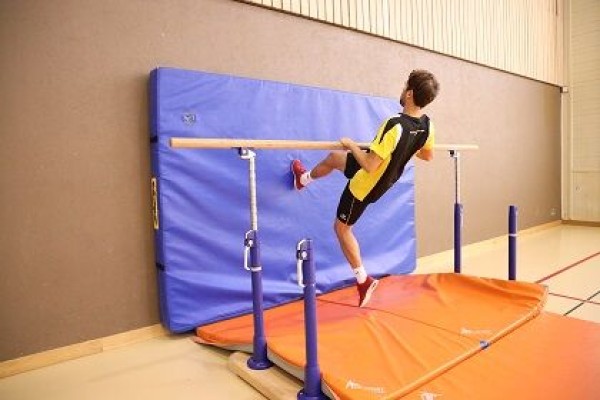
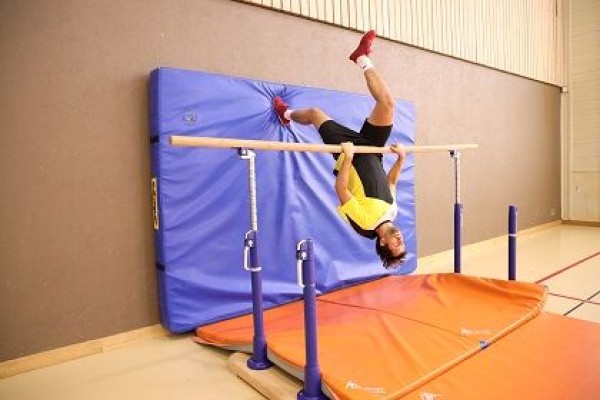
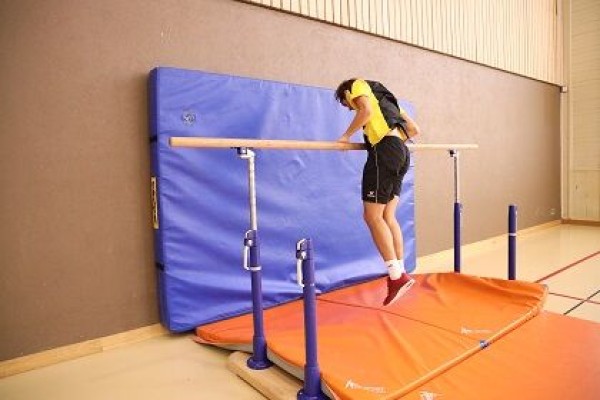
Hold on to the parallel bars with your hands, run up the large soft mat with one or two steps, push off upwards and swing around the parallel bars, resting your head on your neck and landing in the starting position.
Variant:
Exercise performed with a horizontal bar. A large soft mat attached to a vaulting box serves as a "wall".
outdoor:
Hold on to the bar with your hands, perform a powerful push-off with the supporting leg, move the swinging leg over the bar and continue to turn until you reach the support or land safely on the floor again with both legs (hip swing)
1 wall
1 parallel bar
1 soft mat (large)
3-4 soft mats (small)
Variation of the exercise:
1 horizontal bar
1 vaulting box
Indoor set-up:
Place the parallel bar in front of a wall, fix the bars at chest height, place a large soft mat against the wall and lay out a few small soft mats on the floor to secure it.
Variant: Place a large soft mat against a Swedish pole.
Outdoor:
1 pole
Backflip III
Parkour
Group work
Groups of 3
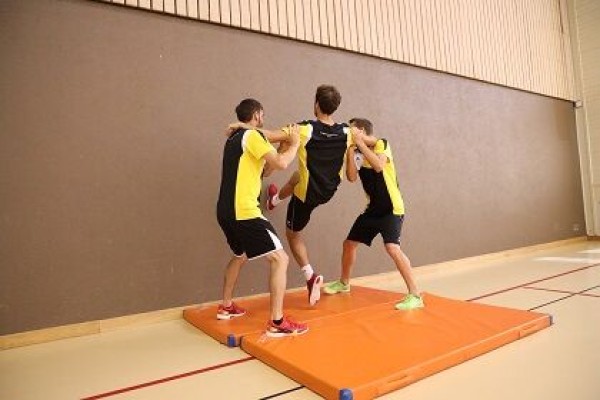
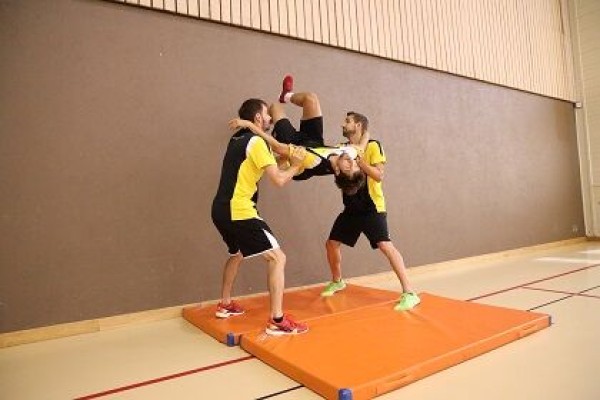
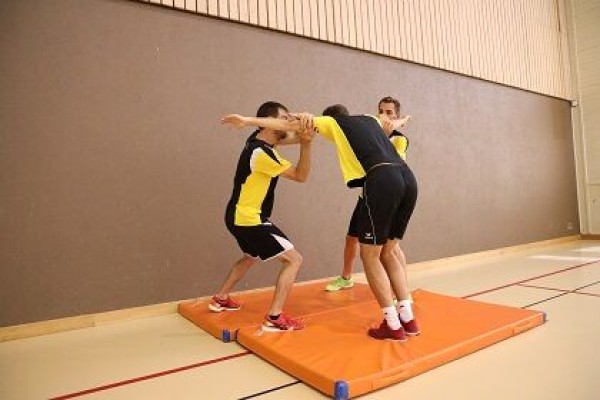
The partners each grab one of the jumper's upper arms from both sides and do not let go until they land safely. Run towards the wall with momentum, run up to shoulder height with one or two feet on the wall and push off, lean your head back and throw your legs in the direction of rotation, turn and land on both legs.
Variant:
Hook a vaulting box top diagonally into the wall bars as an aid and walk up it.
1 wall
2-3 soft mats (small) ► Indoor version
Variation of the exercise:
1 wall bars
1 vaulting box
Backflip IV
Parkour
Partner work

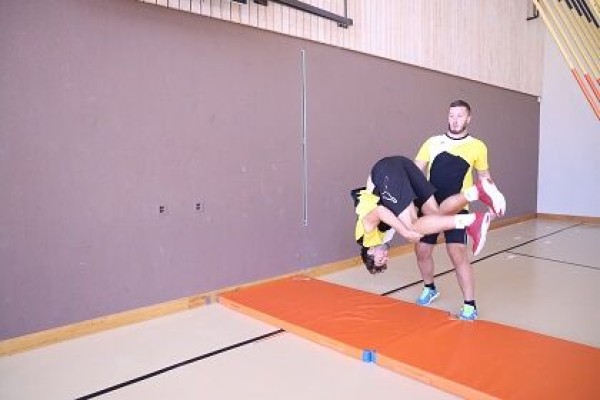
The partner places the hand of the arm further away on the back of the jumper's neck and the other hand on the lower back. The hands accompany the jumper throughout the jump until they reach a safe standing position. Run towards the wall with momentum, run up the wall to shoulder height with one or two feet and push off, rest your head on the back of your neck and throw your legs in the direction of rotation, turn and land on both legs.
Variant:
Hook a vaulting box top diagonally into the wall bars as an aid and walk up it.
1 wall
2-3 soft mats (small) ► Indoor version
Variation of the exercise:
1 wall bars
1 vaulting box
Balancieren
Parkour
Individual work
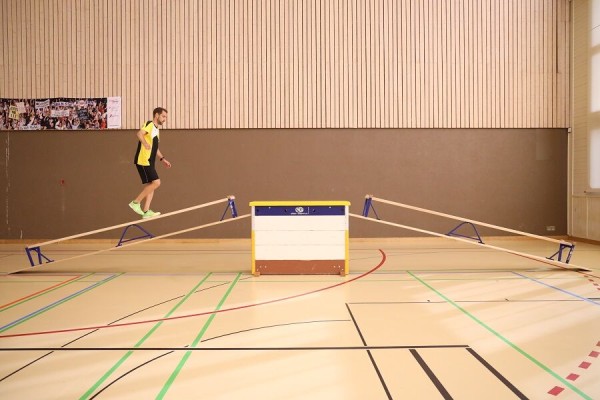
Balancing over the long benches and the vaulting box from one side to the other.
Variations:
Change direction of movement (fw./rw.);
Change type of movement (upright/on all fours);
Change speed.
outdoor:
Walk along a pole or narrow wall in a four-foot stance.
Variant:
Walk backwards.
1 vaulting box ► indoor version
2 long benches ► indoor version
Indoor post setup:
Hook two long benches with the narrow side facing up at both ends of a vaulting box.
outdoor:
Pole or narrow wall.
Balancieren
Parkour
Partner work
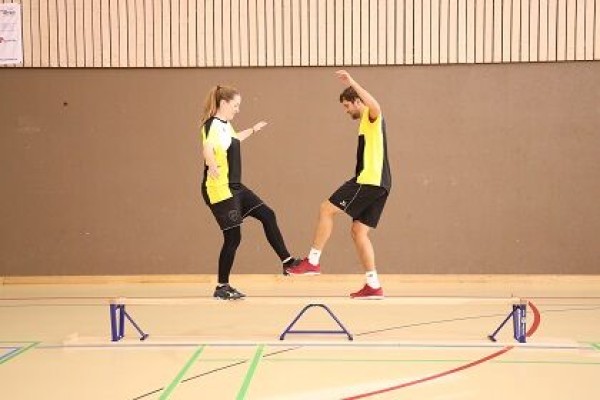

Two participants stand on one leg on the narrow side of a long bench and face each other head-on (stand on a wall, ground line or other elevation ►outdoor version), pressing the inside of the foot of the free leg (also possible with the outside edge of the foot) against the foot of the other person, then trying to push their partner off the bench without losing their balance. Switch legs from time to time.
1 long bench
Indoor post setup:
Narrow side of the long bench points upwards.
Outdoor:
Narrow wall, ground line or other elevation.
Balancieren
Parkour
Individual work


Balancing over long benches and medicine balls from one side to the other.
Variations:
Jumping with one leg from ball to ball;
Jumping with 180 degree turns from ball to ball.
outdoor:
Standing frontally on the pole (e.g. barrier, fence) and balancing. The second person provides assistance so that no one falls.
Variations:
Stand sideways;
Walk on the pole.
2 long benches
3 medicine balls
Indoor set-up:
Three medicine balls lie between two upturned long benches (narrow side facing upwards) at a slight distance from each other.
Outdoor:
A very narrow surface.
Balancieren
Parkour
Individual work
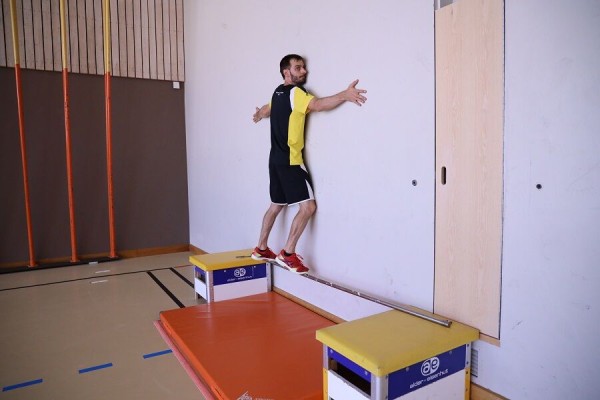
Balance over the horizontal bar from one side of the vaulting box to the other
.2 vaulting boxes
1 horizontal bar
1 soft mat (small)
Post structure:
Place two vaulting boxes (2 elements each incl. top section) on a wall approx. 1.5m apart, place a horizontal bar over the two top sections.
Balancieren
Parkour
Individual work

Balance over the horizontal bars from box to box top.
Variations:
Integrate jumps;
Include 180 and 360 degree turns.
outdoor:
Balance on a narrow ledge and incorporate jumps and 180 or 360 degree turns.
3 vaulting box (upper parts)
2 horizontal bars
Post structure indoor:
Three vaulting box upper parts are placed on the floor and connected with horizontal bars.
outdoor:
a narrow bar/raiser.
Balancieren
Parkour
Individual work
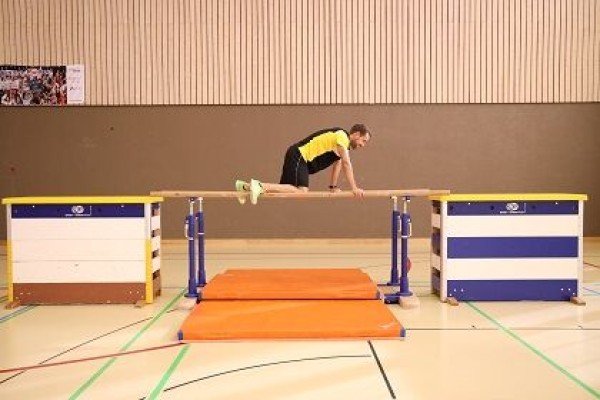
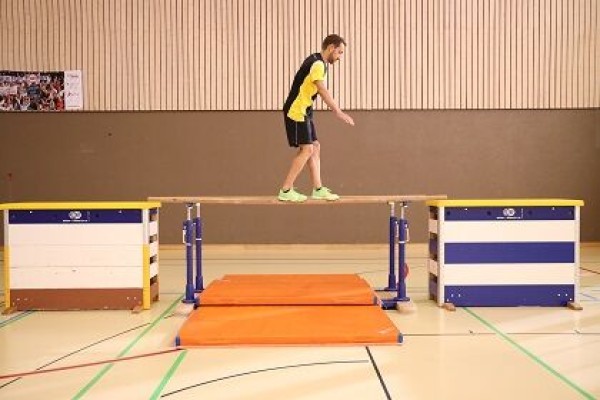
Moving from one vaulting box to the other by crossing the bar on all fours or in an upright position.
1 parallel bars
2 vaulting boxes
2-4 soft mats (small)
Post setup:
Set up two vaulting boxes with a parallel bar in between (lengthwise).
Big Jump
Parkour
Individual work
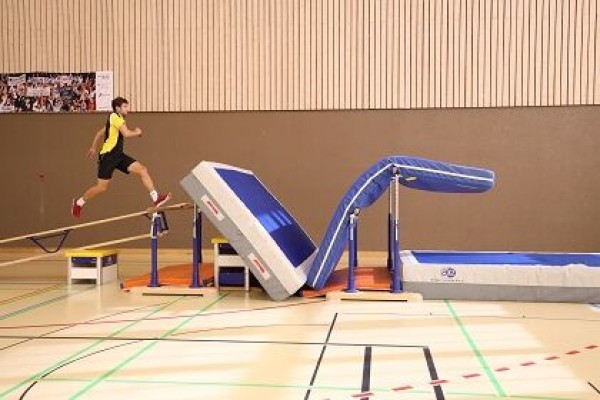
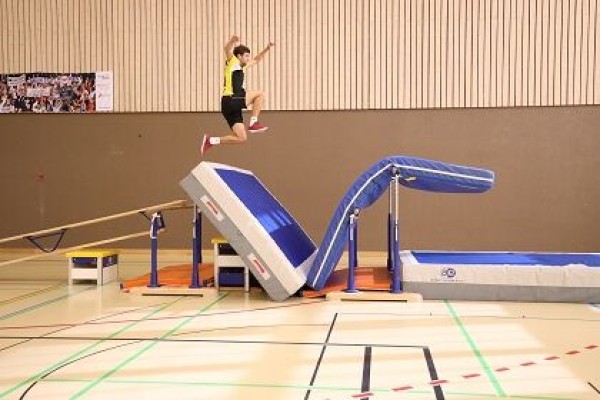
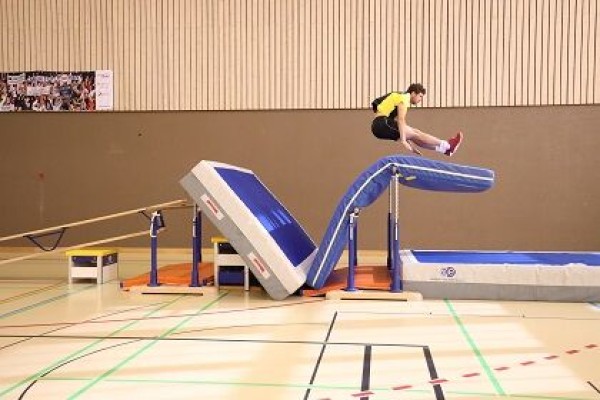
Approach over the long bench, jump onto/over the soft mat further away.
1 long bench
2 parallel bars
2 vaulting box
3 soft mats (large)
2 soft mats (small)
4 skipping ropes
Post set-up:
Exercise set-up as shown; the large soft mats are tied to the parallel bars.
Crane Jump
Parkour
Individual work
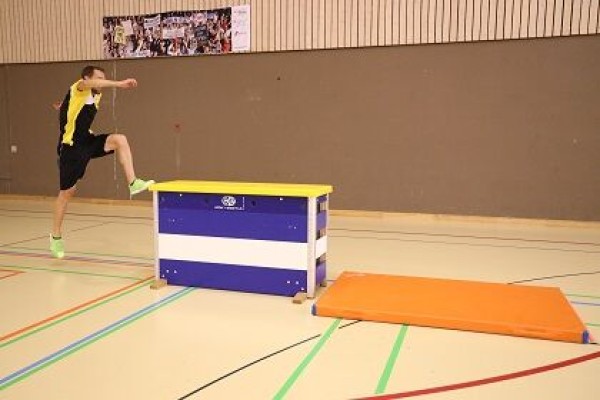
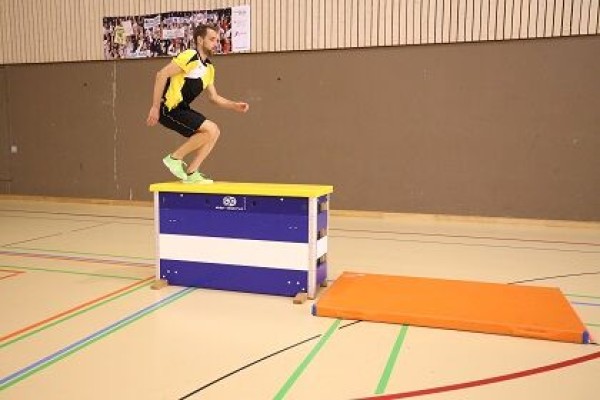
Short run-up to the vaulting box (obstacle - e.g. wall ► outdoor variant), one-legged jump from the run, landing with the other foot on the box (step jump).
Variant:
Place a lower vaulting box in front of the vaulting box (2-3 elements) and jump in a step jump first onto the small box and then onto the large box.
1 vaulting box ►indoor version
1 soft mat (small) ►indoor version
2-3 vaulting box elements incl. top section ►variation of the exercise
Indoor set-up:
Place a soft mat behind a vaulting box.
Variation: Place a lower box in front of the vaulting box.
outdoor:
A raised obstacle (wall or similar).
Thief jump I
Parkour
Individual work
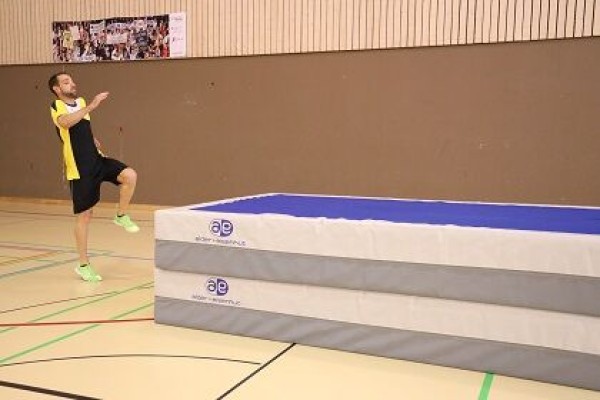
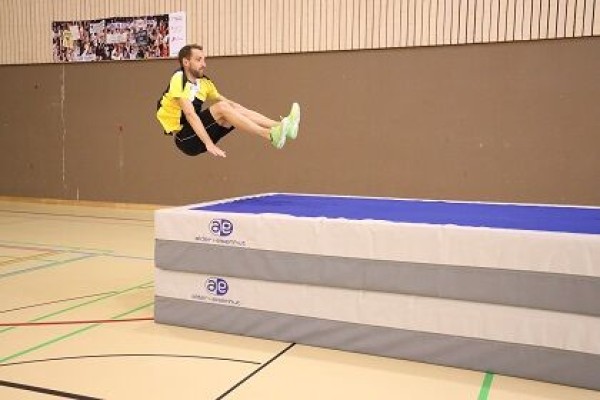
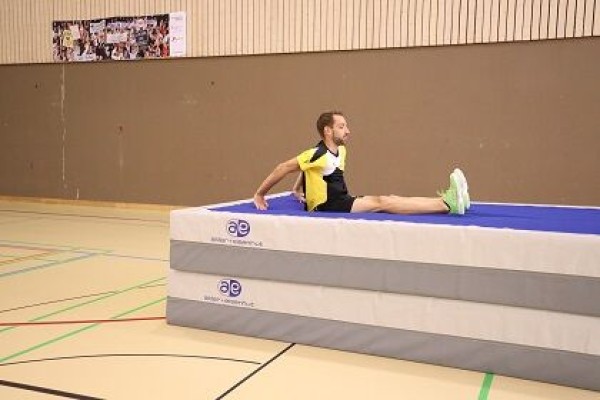
Strong run-up, frontal take-off approx. one leg length in front of two soft mats lying on top of each other, pull your legs up quickly in the air and bring them forwards in a horizontal position, hit the mat hard with both hands when landing in the seat.
Variant:
Lower mat height (only 1 soft mat).
2 soft mats (large)
Post structure:
Place two large soft mats on top of each other.
Thief jump II
Parkour
Individual work
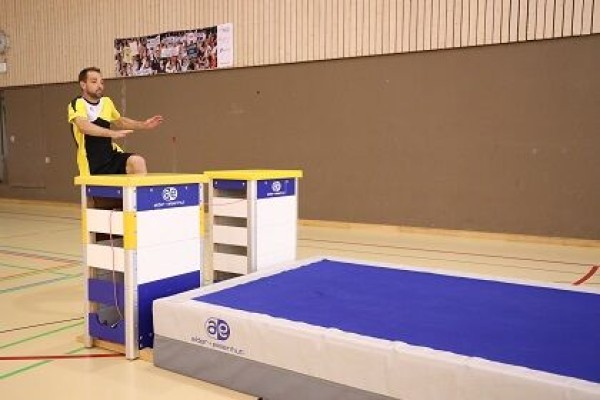

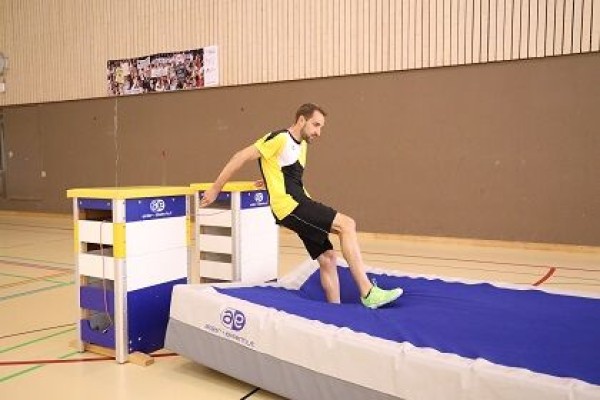
Strong run-up, frontal take-off approx. one leg length in front of the obstacles, pull your legs up quickly and bring them forwards in a horizontal position, push off the vaulting box with both hands.
Variant:
Vary the height of the box.
2 vaulting boxes/pommel horses
1 soft mat (large)
1 elastic rubber band
Post set-up:
Place two vaulting boxes next to each other at a distance of approx. 50 cm, place a large soft mat behind them, stretch an elastic rubber band between the vaulting boxes if necessary
Thief jump III
Parkour
Individual work
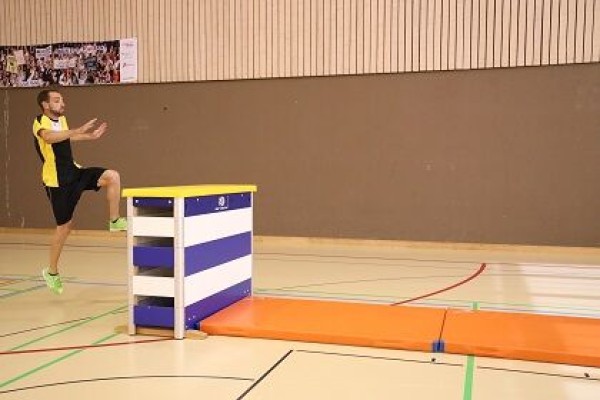
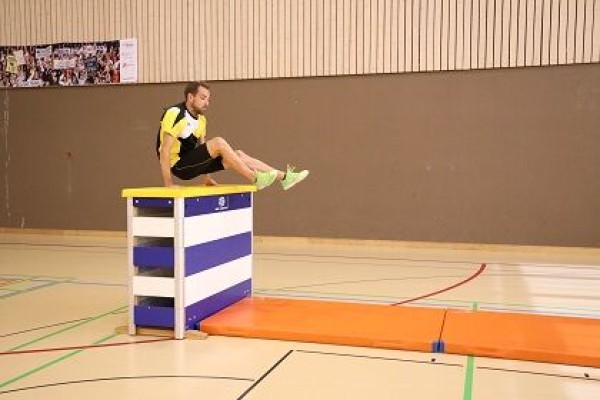

Strong run-up, frontal take-off approx. one leg length in front of the vaulting box, pull your legs up quickly and bring them forwards horizontally, push off the box forcefully with both hands to land, continue running directly after landing.
Variant:
Vary the height of the box.
1 Swedish box/pommel horse
Swivel squat I
Parkour
Individual work


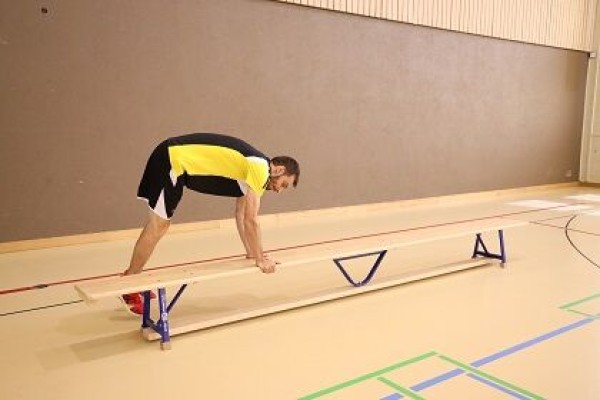
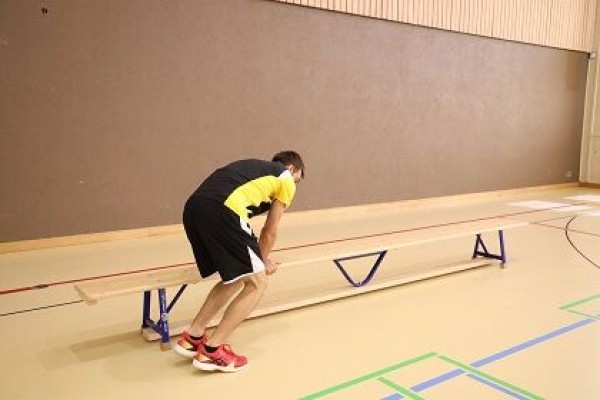
Stand on one side of the long bench, hold on to the edges of the wide side of the long bench with your hands, jump over the bench in as high a squat as possible (squat turn), land on the other side of the long bench.
Variant:
Place balls on the long bench, over which the legs must be guided.
1 long bench
2-3 medicine balls ► Variation of the exercise
Swivel squat II
Parkour
Individual work
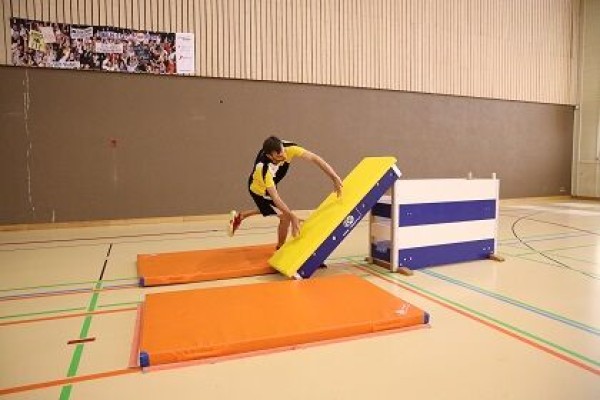
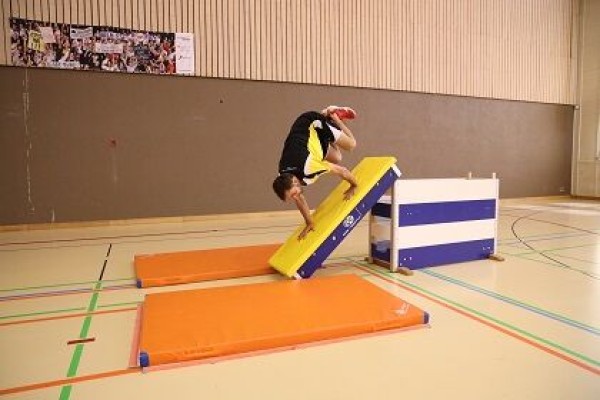

Slow run-up, place your hands on the top of the vaulting box (the upper hand points horizontally in the direction of the jump, the lower hand points towards the ground), jump over the vaulting box with your legs drawn up (squat turn), landing on both legs on a small soft mat.
Variant:
Set up the top of the vaulting box more firmly (e.g. on a wall bar).
1 vaulting box
2 soft mats (small)
1 wall bars ► Variation of the exercise
Post setup:
The top element is leant against the vaulting box at an angle, with small soft mats on both sides.
Swivel squat III
Parkour
Individual work
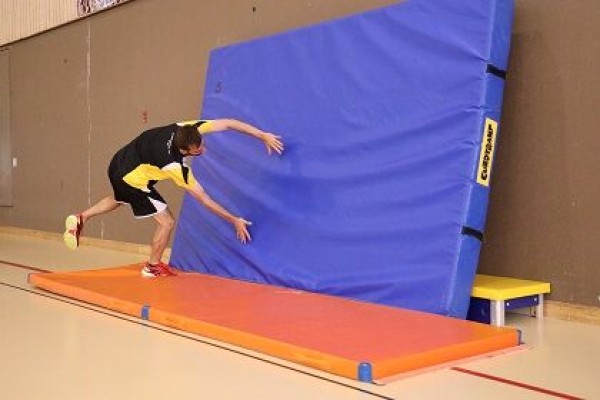
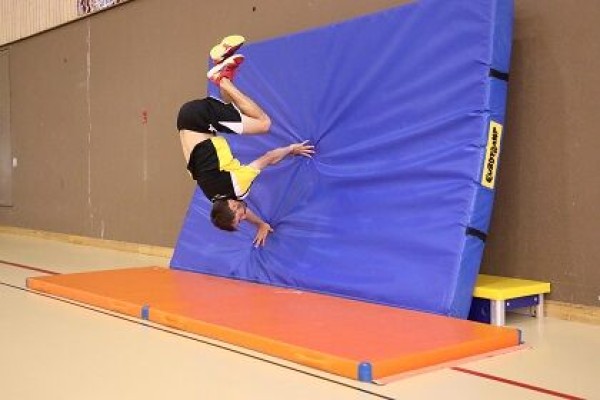

Approach the large soft mat at a 45-degree angle, place your hands in the centre of the mat (the upper hand points horizontally in the direction of the jump, the lower hand points towards the floor), jump with both legs and bring your legs tucked over your body to the other side (squat turn), land with both legs.
Variant:
Increase/decrease the angle of the large soft mat.
1 wall
1 vaulting box
1 soft mat (large)
1 soft mat (small)
Post setup:
Place the large soft mat at an angle against a wall and stabilise with vaulting box elements (i.e. place behind the mat), place the small mats in a row in front of the large soft mat.
Swivel squat IV
Parkour
Individual work
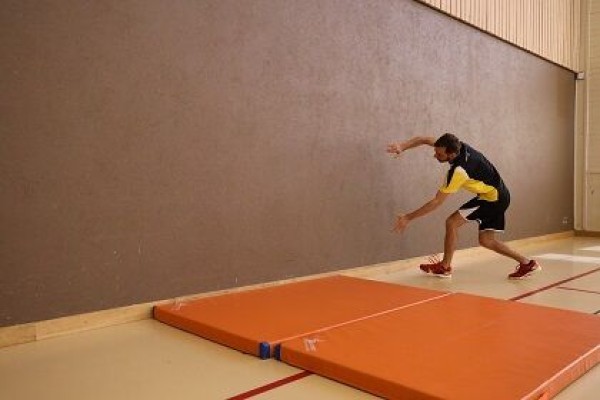
Approach the wall at a 45 degree angle, jump off with both legs, grab the wall with your hands (the upper hand points horizontally in the direction of the jump, the lower hand points towards the floor), pull your legs over your head to the other side (squat turn), land with both legs.
1 wall
1-2 soft mats (small)
Post setup:
Place soft mats on the floor in front of a wall.
Swing through I
Parkour
Individual work
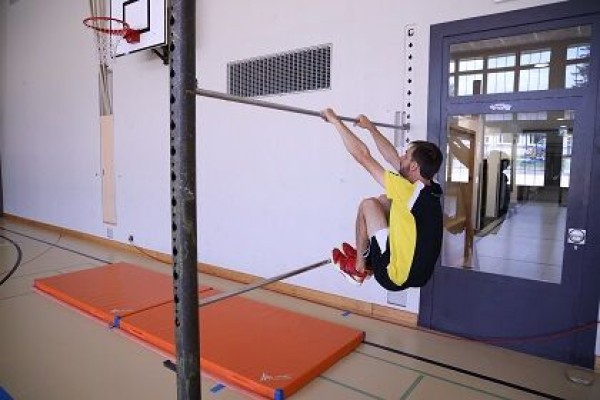
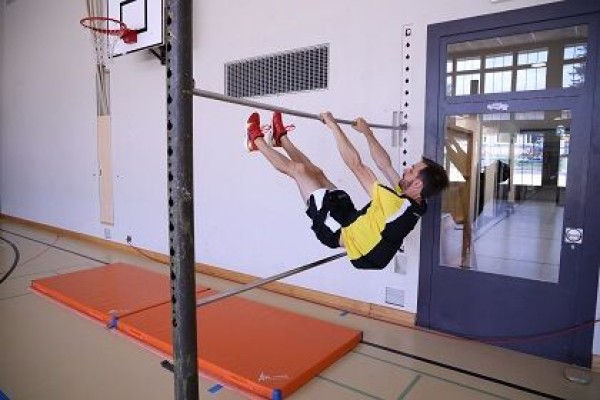
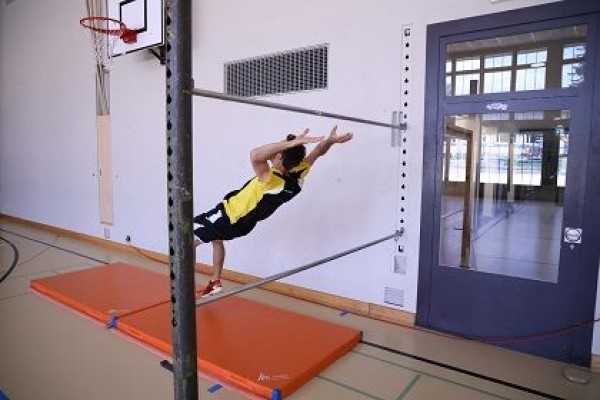
Squat on the lower horizontal bar, hold on to the upper bar with both hands, swing through between the two horizontal bars to land on the soft mat behind.
Variant:
Roll off after landing.
outdoor:
Stand on the front of the bar. Hold the pole with both hands. Swing under the (horizontal) bar to land on the other side.
1 horizontal bar ►indoor version
1 additional horizontal bar ►indoor version
2 soft mats (small) ►indoor version
Indoor pole assembly:
Fix two horizontal bars at different heights (approx. 1m apart).
outdoor:
1 pole
Swing through II
Parkour
Individual work
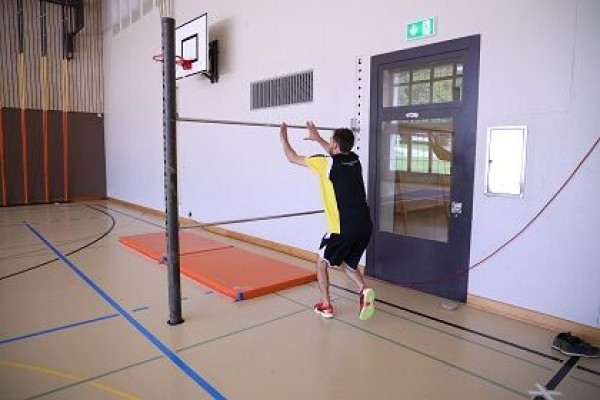
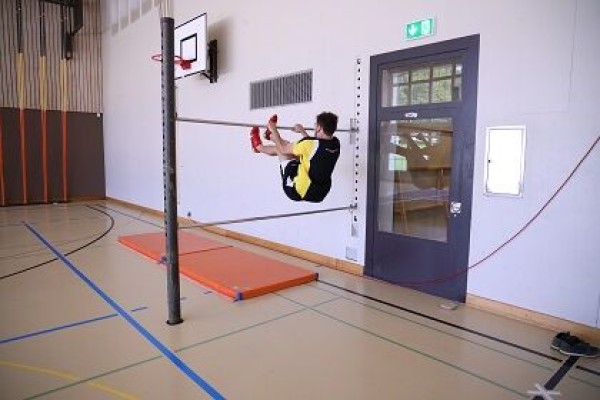

Frontal run-up and two-footed jump, hold on to the upper horizontal bar with both hands and swing between the two bars (underswing), two-legged landing on the other side (soft mat behind it ►indoor variation).
Variants:
Vary the height of the horizontal bars;
roll off after landing.
1 horizontal bar ►indoor version
1 additional horizontal bar ►indoor version
2 soft mats (small) ►indoor version
Indoor post setup:
Fix two horizontal bars at different heights (approx. 1m apart).
outdoor:
1 (horizontal) bar
Jump through I
Parkour
Individual work
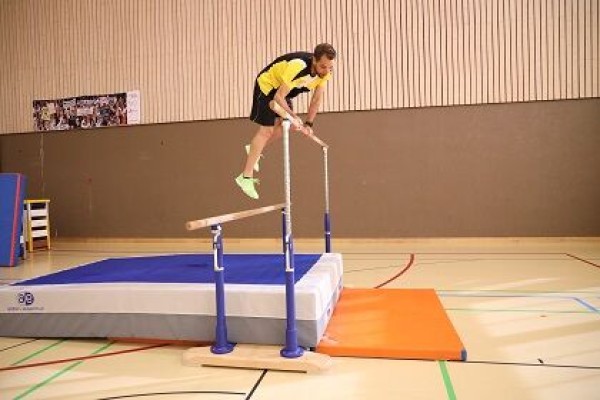
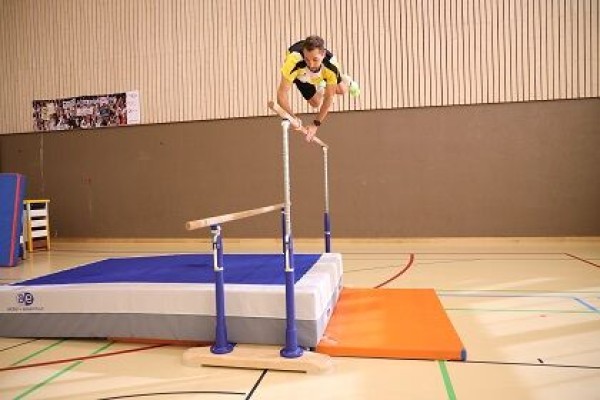
Stand on the low side of the uneven bars and hold on to the higher bars with your hands. Jump off with both legs for a squat turn over the high bars, landing on the small soft mat.
Variant:
Change the height of the bars.
1 parallel bars
1 soft mat (large)
1 soft mat (small)
Post setup:
Fix the parallel bars at different heights (distance: approx. 50 cm), place a small soft mat under the parallel bars and a large soft mat behind it.
Jump through II
Parkour
Individual work
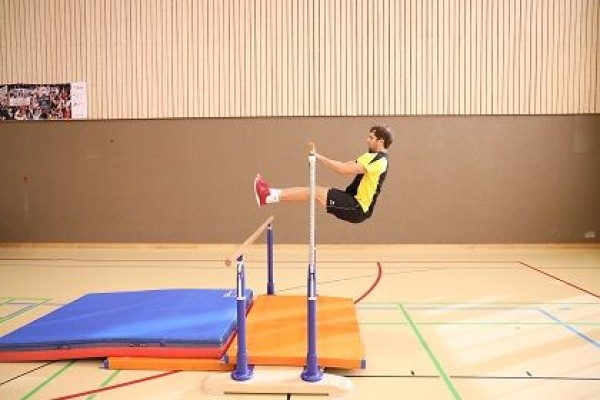
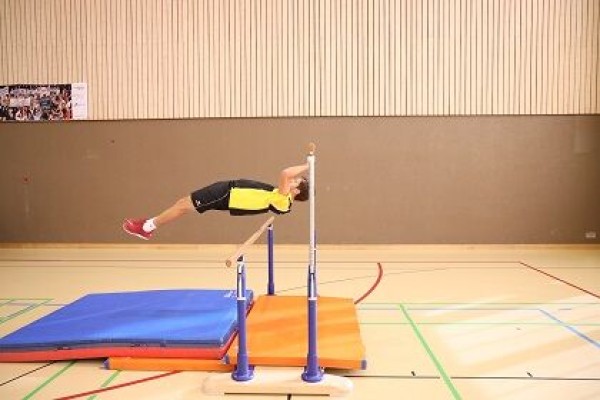
Frontal approach to the uneven bars (front: high bars), hold on to the upper bars and swing through the uneven bars (underswing). Land on the large soft mat.
Variant:
Increase/decrease the distance between the bars (both vertically and horizontally).
1 parallel bars
1 soft mat (large)
1 soft mat (small)
Post setup:
Fix the parallel bars at different heights (distance: approx. 50 cm), place a small soft mat under the parallel bars and a large soft mat behind it.
Jump through III
Parkour
Individual work
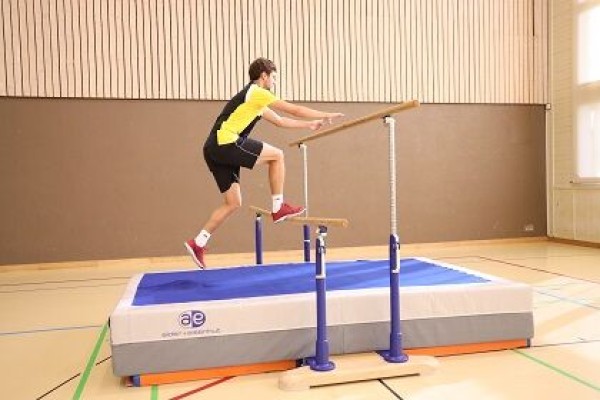
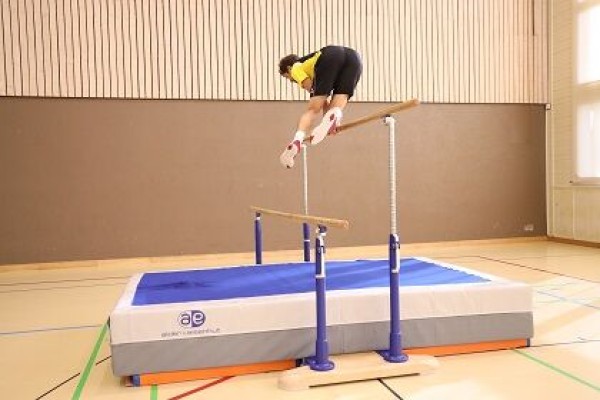
Frontal run-up to the uneven bars (front: low bars), jump onto the low bars, squat turn over the high bars (180 degree turn), landing with the feet on the low bars, hands still holding the high bars.
Variant:
Exit with underswing between the two bars without a support.
1 parallel bars
1 soft mat (large)
Post setup:
Fix the parallel bars at different heights (distance: approx. 50cm), place a large soft mat under the parallel bars.
Introduction to HiBa in the field: playful form
Obstacle course in the terrain
The obstacle course is divided into six sectors. The first sector is assigned the number 6 and the last section the number 1. A throwing field is set up next to the obstacle course. There, throwing discs (frisbees) can be thrown at a target. The target can be a tyre lying on the ground or a tyre suspended from two paint sticks with ribbons (do not make the targets too easy, but not too difficult either). A flipchart is placed between the obstacle course and the throwing field for the evaluation.
The game works as follows: the participants throw at the targets on the throwing field. They have a maximum of six attempts. If they fail to hit a target, the participants complete a marked-out lap around the obstacle course and are then allowed six new attempts to hit the target. If a hit is scored, part or all of the obstacle course can be passed. If the hit is successful after the first attempt, all obstacles may be attempted. If the participant hits the target on the third attempt, for example, they can run through the obstacle course up to and including section three. This means that the competitor throws until the first hit (multiple hits are not possible) or, if no hits are made, an additional round must be completed as mentioned above. If the participant is successful and has passed a section or the entire obstacle course, they can then cross off the corresponding number (number of attempts until they hit the target) on the flipchart. If, under certain circumstances, the target is hit a second time with only one attempt, the entire obstacle course is available again and the participant can choose until and with which partial distance the obstacles are run in order to cross off a missing number on the flipchart. The game is over for the participants when they have ticked off the numbers 1-6 on the flipchart. The fewer throws required for a hit, the easier it is to complete the exercise. If, for example, only the number two is missing at the end, but the target has not been hit after two attempts, a running round is completed and you can then throw at the targets again. If necessary, adapt the exercise to the time conditions and finish after the first ranks if necessary.
x tyres (adjust the number of targets to the number of participants)
x colouring sticks (optional depending on the target)
x game tapes (optional depending on the target)
1 route tape
1 flipchart (evaluation prepared)
x throwing discs (frisbees)
8 fanjons
6 F-discs with pegs (numbers 1-6)
Hinbernis track in the terrain
Before each use of the HiBa terrain, the elements must be checked for their suitability and the running track must be cleaned/removed of foreign objects. Minimising the risk of injury (e.g. avenging gravel pits on the climbing wall) is the responsibility of the sports manager and has top priority.